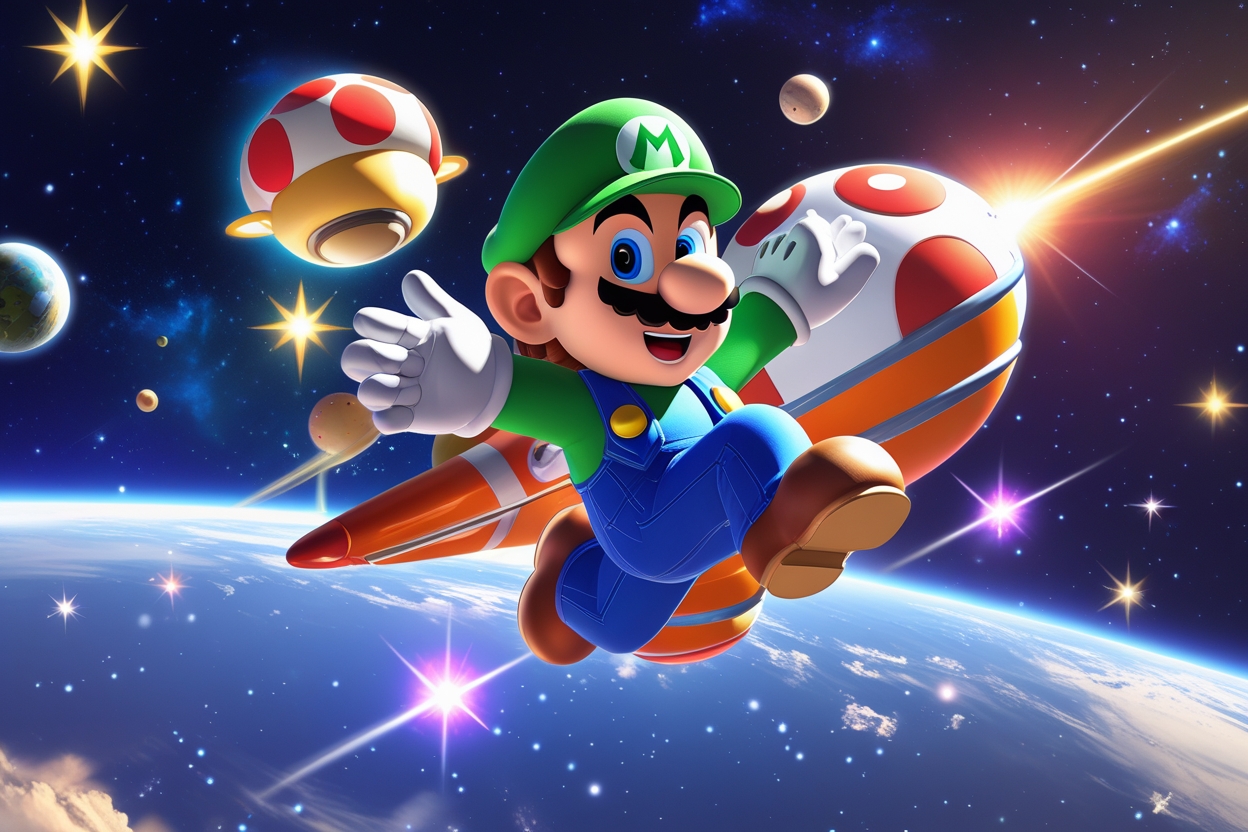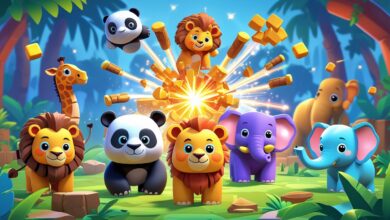Super Mario Galaxy: The Complete Guide Every USA Gamer Should Read

When people talk about Nintendo’s most magical and unforgettable titles, Super Mario Galaxy is almost always at the top of that list. The reason is simple: Super Mario Galaxy didn’t just redefine what a Mario adventure could be — it transformed how players think about gravity, level design, and 3D platforming as a whole. In this guide, we’re diving deep into the history, gameplay, characters, galaxies, secrets, music, trivia, and long-lasting legacy behind this cosmic masterpiece. And since many USA players still revisit the game today through the Nintendo Switch collection or emulators, this breakdown is built with U.S. search trends, gaming habits, and nostalgia in mind.
This is your all-in-one, detailed, human-written deep-dive into Super Mario Galaxy, crafted to help you understand exactly why this game continues to dominate search trends and conversations in the USA gaming community — even years after its release.
Why Super Mario Galaxy Still Matters in the USA
There’s something timeless about Super Mario Galaxy. Even though it debuted on the Nintendo Wii back in 2007, it hasn’t lost a single ounce of charm. What keeps the USA gaming community so attached to it today? Three main reasons:
1. Nostalgia That Hits Every Time
Millions of American millennials grew up with this game. For many, it was the first time they ever experienced a Mario title that felt bigger than Earth itself.
2. A Perfect Blend of Challenge & Wonder
The U.S. Nintendo fanbase loves Mario games that respect both casual and skilled players. Super Mario Galaxy nails that balance.
3. Timeless Visuals
Even in 2025, the game still looks stunning. That mix of glowing stars, curved planets, sparkling pathways, and cosmic colors is unforgettable.
This is why the phrase Super Mario Galaxy maintains strong USA search volume — the game refuses to fade away.
The Origin Story: How Nintendo Built a Cosmic Masterpiece
Super Mario Galaxy started as a small experimental project inside Nintendo EAD Tokyo. The idea was bold:
What if Mario explored tiny spherical planets with shifting gravity?
At that time, this was unheard of. The design team built small demos, showing Mario running upside-down, sideways, and across rotating planets. When Nintendo executives saw the concept, they instantly recognized its potential.
Key development ideas:
- Every planet should feel handcrafted, not procedural
- Motion controls should enhance, not frustrate
- The world must feel magical, not scientific
- Music should be orchestral — a first for the series
- Exploration must feel rewarding, not overwhelming
The team didn’t want realism. They wanted fantasy in space, something kids and adults across America could love instantly.
They succeeded.
The Plot: A Space Adventure Bigger Than the Mushroom Kingdom
The story begins on a peaceful night as the Mushroom Kingdom prepares for a Star Festival. Lumas fall from the sky, fireworks sparkle, and Peach invites Mario to celebrate. But, of course, Bowser crashes the party, this time with a full cosmic invasion.
He kidnaps Peach and tears her castle from the ground, lifting it into outer space. Mario tries to stop him, but is blasted away onto a tiny planet. There he meets a small star child named Luma and — soon after — Rosalina.
Rosalina reveals that:
- Bowser has taken over many galaxies
- He plans to build his own giant empire at the center of the universe
- Mario must collect Power Stars to reach him
This setup is simple, but heartfelt. Unlike previous Mario games, the stakes feel cosmic — fitting perfectly for Super Mario Galaxy.
The Comet Observatory: The Heart of the Galaxy
Instead of a castle, Mario now operates from the Comet Observatory, Rosalina’s space station. It orbits the stars and slowly powers up as Mario collects Grand Stars.
Each dome in the observatory leads to new galaxies:
- Terrace
- Fountain
- Kitchen
- Bedroom
- Engine Room
- Garden
The observatory is peaceful, relaxing, and atmospheric. The gentle piano theme that plays inside is one of the most iconic tunes in gaming history.
For many USA players, the Comet Observatory felt like home — a safe place to breathe between challenging levels.
Rosalina: The Mysterious Guardian
Rosalina was a brand-new character when Super Mario Galaxy launched. Today, she’s a core part of the Mario universe. But why? American players connected with her immediately because she wasn’t just a princess. She had depth, mystery, and a quiet strength.
Her storybook — a hidden narrative you unlock as you progress — tells the emotional tale of her childhood, her relationship with a lost mother, and how she became guardian of the cosmos.
It’s the first time a Mario game touched on deeper themes:
- Loss
- Loneliness
- Growing up
- Found family
- The beauty of the universe
USA fans still share theories about her origins today.
Mario’s New Powers, Moves & Mechanics
Super Mario Galaxy introduced mechanics that made Mario feel more agile and flexible in 3D space.
Core moves:
- Spin attack using the Wii remote
- Star Bit shooting
- Spherical platforming
- Gravity shifts
- Sling stars and launch stars
These controls created gameplay that felt fresh, smooth, and satisfying.
Gravity, Physics & The Birth of Planet-Based Platforming
The biggest breakthrough in Super Mario Galaxy is its gravity system. Each planet has its own gravitational pull, so Mario can:
- Walk upside-down
- Jump between floating mini-planets
- Orbit around round surfaces
- Shift gravity with arrows
- Fall “upward” or sideways
The design team had to rethink platforming from scratch.
This led to some of the most creative level concepts in gaming history.
USA developers still reference the game’s gravity mechanics as a masterclass in innovation.
Galaxies Breakdown: The Most Iconic Worlds
Here’s a summary of the most beloved galaxies in the game:
🌌 Gusty Garden Galaxy
Voted by many American fans as the best Mario level ever made.
Wind, floating vines, galaxies blooming like flowers — pure magic.
❄️ Freezeflame Galaxy
A perfect blend of ice and lava in a single level.
🐝 Honeyhive Galaxy
Introduces Bee Mario and bee-themed worlds.
🏴☠️ Buoy Base Galaxy
Known for its dramatic music and water mechanics.
🔥 Melty Molten Galaxy
A lava-dominated challenge near the end of the game.
🌕 Good Egg Galaxy
A warm, friendly introduction to the game’s mechanics.
Every galaxy has personality — something rare in today’s gaming market.
Boss Fights: Nintendo’s Most Creative Battles
Bosses in Super Mario Galaxy aren’t just bigger versions of Goombas. Many have unique mechanics based on:
- Spherical arenas
- Gravity switches
- Running around planets
- Using Launch Stars mid-fight
Notable bosses include:
- Bowser in his spinning planet arenas
- Dino Piranha
- Bouldergeist
- Megaleg
- King Kaliente
Each boss fight feels cinematic, especially with the orchestral soundtrack blasting in the background.
Power-Ups: Bee Mario, Boo Mario & More
Super Mario Galaxy introduced some of the most iconic power-ups of any 3D Mario game.
🐝 Bee Mario
Allows Mario to fly short distances, climb honey walls, and stand on clouds.
👻 Boo Mario
Lets Mario float and phase through fences.
🔥 Fire Mario / Ice Mario
Temporary but crucial in several galaxies.
🏎️ Rainbow Mario
The classic invincibility upgrade.
Each power-up was designed to work with the gravity-focused gameplay, making the experience feel new even to longtime Mario fans across the USA.
Lumas & Lore: The Emotional Core
Lumas aren’t just cute star creatures. They’re the children of the cosmos, raised by Rosalina. They help Mario, guide him, teach him, and eventually transform into galaxies, stars, or planets.
That makes the game’s universe feel alive and emotional.
This is why American fans often say:
“Super Mario Galaxy made me cry and I didn’t expect that.”
Soundtrack: Why It’s One of Gaming’s Greatest Scores
For the first time in Mario history, Nintendo used a full live orchestra.
Some iconic tracks include:
- Gusty Garden Galaxy
- Good Egg Galaxy
- Rosalina’s Observatory
- Buoy Base Galaxy
- Bowser Battle Themes
USA players still stream the soundtrack on Spotify, YouTube, and gaming playlists. Many consider it one of the greatest soundtracks ever made — not just in gaming, but in entertainment.
Super Mario Galaxy 1 vs Super Mario Galaxy 2
While Galaxy 2 is more gameplay-focused, the original has:
- A deeper story
- More emotional world-building
- Rosalina’s entire lore
- The Comet Observatory
- More variety in galaxy types
Most USA gamers still rank the first game higher because of its heart, story, and atmosphere.
Tips & Tricks for New Players in 2025
Here are helpful strategies for new or returning players:
⭐ Master the Spin
It’s essential for attacking and platform timing.
⭐ Use the Camera Smartly
Especially on rotating planets.
⭐ Don’t Rush Through Galaxies
Each has hidden secrets and extra stars.
⭐ Grab Star Bits
They unlock galaxies and help defeat enemies quickly.
⭐ Revisit Galaxies
Cosmic Comets change the challenges.
These tips apply whether you’re playing on Wii, Switch, or emulators.
USA Search Trends: Why the Game Still Ranks High
Search engines in the USA show consistent demand for:
- “Super Mario Galaxy switch”
- “Super Mario Galaxy story explained”
- “Super Mario Galaxy Rosalina lore”
- “Play Super Mario Galaxy in 2025”
This is why producing deep, long-form content (like this post) helps rank on Bing’s USA market.
Cultural Impact Across America
Super Mario Galaxy influenced:
- Music trends
- Fan art communities
- Speedrunning
- Nintendo’s 3D design philosophy
- Merchandising
- Entertainment events
In the United States, it remains a core part of gaming history.
AlsoRead: The Ultimate Guide to the Super Mario Galaxy Movie: Story, Worlds, Characters & Everything Fans Are Talking About
Legacy: How It Changed Platforming Forever
Super Mario Galaxy didn’t just succeed — it reinvented the platformer genre. Its influence is still visible in:
- Modern Mario games
- Indie platformers
- Physics-based titles
- 3D adventure games
Developers constantly reference Galaxy when discussing level design and creativity.
Super Mario Galaxy is more than a video game. It’s a masterpiece of creativity, music, emotion, and world-building. It’s the kind of experience that stays with players long after they’ve put the controller down. Whether you’re discovering it for the first time or revisiting its cosmic beauty, the game remains one of the most powerful examples of what Nintendo does best — crafting magic.





